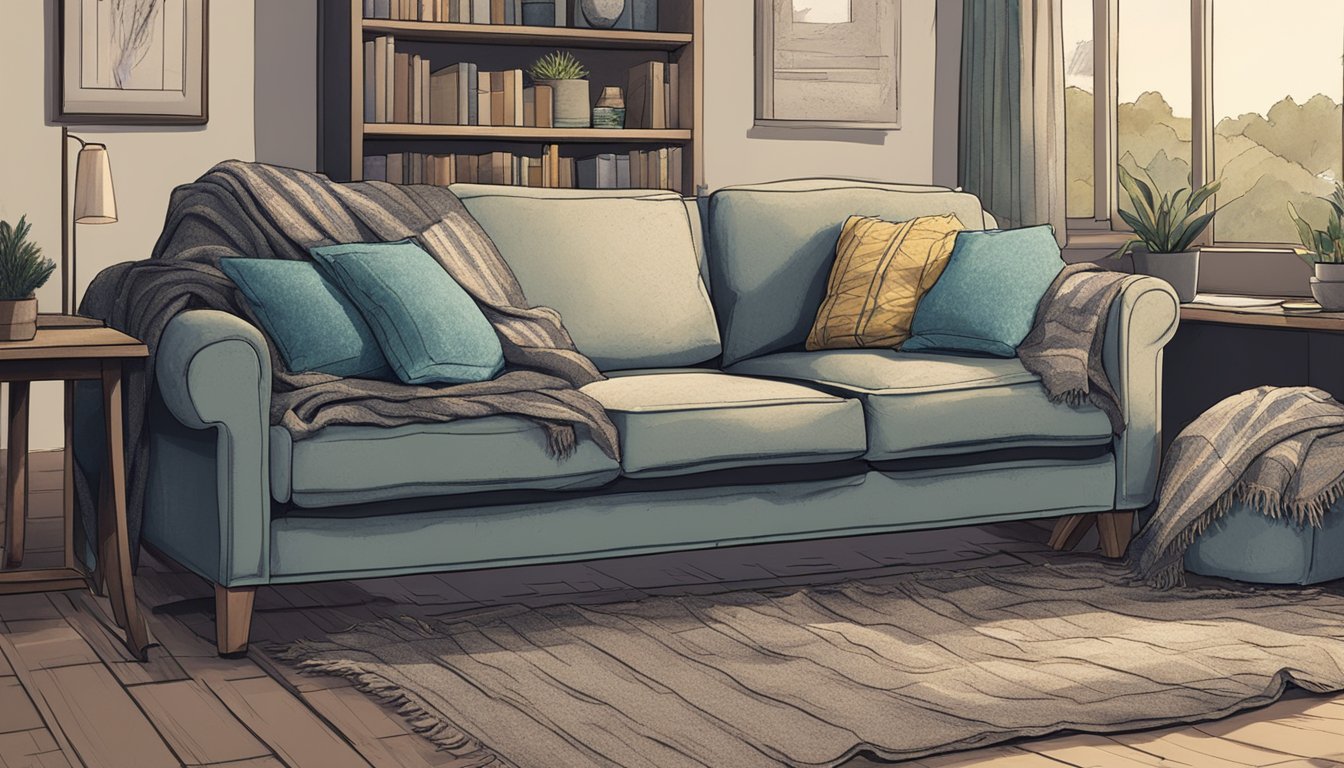When I first got my couch, it seemed like it would last forever—comfy cushions, the perfect color, and just the right size for my living room. But as the years have passed, I’ve started to notice that it doesn’t quite feel the same. I’ve learned that the lifespan of a typical sofa is around seven to fifteen years, depending on various factors like usage, material quality, and maintenance.

I came across some signs that indicate it’s time to start looking for a replacement. For instance, if the cushions are sagging despite attempts to fluff them or if there’s noticeable structural damage, it’s a clear signal that my sofa’s days are numbered. The presence of persistent odors, wear and tear on the fabric, and increasingly uncomfortable seating also suggest that my cozy spot might not be serving its purpose as well as it used to.
Understanding Couch Lifespans

When I think about a couch’s lifespan, several factors come to the forefront. My experience in furniture retail has shown that the average lifespan of a couch can vary greatly. Typically, a well-made upholstered sofa should serve you comfortably for about 7 to 15 years, while leather sofas can push the boundary to 15 to 20 years, thanks to their durability.
Factors Affecting Durability:
- Use: The more frequently a couch is used, the shorter its lifespan tends to be.
- Quality: A higher price often reflects better craftsmanship and materials, which translates to longevity.
- Frame: A sturdy frame signals a longer-lasting couch. Hardwoods are premium choices.
- Material: Leather and high-quality fabrics withstand wear better than cheaper alternatives.
- Maintenance: Regular care prolongs a couch’s life, be it leather conditioning or fabric protection.
Here’s a quick glance at what to expect:
| Material | Expected Lifespan |
|---|---|
| Leather | 15-20 years |
| Fabric | 7-12 years |
It’s evident that couches aren’t built to last forever. But if I invest in a quality piece and maintain it well, I maximize its life. Whether I decide on a sleek leather piece or a cozy fabric one, the key is consistent care and realistic expectations about its durability. Remember, even top-notch sofas eventually show their age.
Signs of Wear and When to Replace

In my experience, keeping an eye out for telltale indicators of wear can tell you when it’s time for a couch to head to the big living room in the sky.
Identifying Common Wear and Tear
When I look over a couch, I’m on the hunt for stains, tears, or faded areas in the fabric. These are often the first signs of a well-loved sofa starting to show its age. If the upholstery isn’t salvageable and reupholstering isn’t an option, it might be time to start shopping.
Assessing Cushion and Frame Deterioration
Cushions should be full and firm, not flat and uncomfortable. When I press down and they don’t spring back, the foam or filling is likely past its prime. As for the frame, if I detect any creaking sounds or noticeable give in the joints and springs, that’s a red flag indicating structural damage. At this stage, repair can be more costly than replacement.
Recognizing When Replacement is Necessary
Let’s face it, when sagging cushions and structural woes combine with a level of uncomfort that rivals sitting on a bed of nails, it’s time to recall my couch’s glory days and replace it. If restorative repairs don’t add up to improved comfort, it’s more rational for me to invest in a new piece that guarantees comfort and stability.
Maintenance and Care for Longevity
When I’m looking to keep my couch in tip-top shape for the long haul, I pay close attention to cleaning and maintenance routines. Here’s my go-to checklist to ensure my sofa stays cozy and welcoming for as long as possible.
- I make a point to vacuum my couch weekly to get rid of crumbs and dust. For those with allergies like me, it’s a game-changer.
- For spill management, I tackle them promptly with the correct cleaner to prevent stains.
Leather Care:
- If I had a leather couch, I’d use a good quality leather conditioner every 6-12 months to keep it supple and prevent cracks.
Fabric Sofa Tips:
- I’ve learned that various upholstery fabrics require specific cleaners, so I always test on a small hidden area first.
Prevent Sun Damage:
- I made the mistake once of placing my couch in direct sunlight; it faded fast. Now I prefer spots away from windows or I use curtains to block harmful rays.
Cushioning Concerns:
- I fluff my cushions regularly to keep them from developing permanent dips. Plus, I rotate them to even out wear.
- A couch with high-density foam is a wise investment, as it bounces back better than its softer counterparts.
In essence, a little time spent on maintenance can add years to your couch’s life. Trust me, your future self (and your wallet) will thank you for it!
Choosing a Durable Couch
When I’m in the market for a new couch, I focus on two main things: materials and construction for longevity, and style and comfort that match my personal preferences.
Materials and Construction Considerations
I always look for high-quality construction because it’s the cornerstone of durability. Sofas with solid hardwood or metal frames are my go-to options, especially if they’re kiln-dried to remove moisture which can lead to warping. I avoid couches with frames made from particleboard or plastic because they’re more prone to breakage.
In terms of joinery, I opt for couches that use dowels, blocks, or metal screws and brackets. If I’m considering a higher investment piece, I might look for sofas with eight-way hand-tied springs, which have a reputation for superior support and longevity over serpentine springs.
When it comes to upholstery, genuine leather ranks high for me due to its longevity, but I also consider durable fabrics such as:
- Polyester or microfiber: For their resilience and easy cleaning.
- Wool or cotton blends: As they offer a balance of comfort and durability.
- Olefin or performance fabrics: These are often recommended for heavy-use family rooms due to their strong wear resistance.
Materials like bonded leather or thin fabrics won’t make the cut for me—they wear out much faster.
Style, Comfort, and Personal Preferences
While durability is a key factor, I also prioritize style and comfort. I’m drawn to a couch that complements my living room and reflects my personal style, whether it’s modern, traditional, or somewhere in between.
Comfort is non-negotiable, so I make sure to test out the cushions. Firmness and resilience are indicators of good quality, and I prefer cushions that have a high-density foam core. I also check for reinforced corner blocking which adds stability.
Personal preferences play a big role, too. I think about:
- The type of upholstery material that feels best to me – some people love the feel of leather, while I might prefer the coziness of linen or microfiber.
- The design – I look for a couch that’s not just trendy but will remain appealing to me over time.
- The practicality for my lifestyle – easy to clean fabrics matter a lot if I’m dealing with pets or kids.
Choosing the right couch is definitely a balancing act between these considerations, but finding the perfect blend can lead to a long-lasting, satisfying investment.








